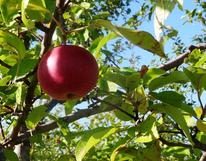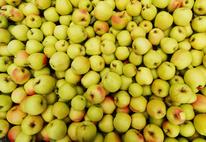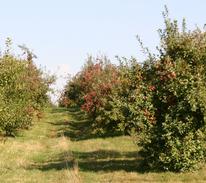By Michelle Miller
Edited by Steve Simmons, Kristine Moncada, Craig Sheaffer, Gigi DiGiacomo and Nicole Tautges
The Hochs are a second-generation orcharding family. The Hoch orchard lies along the Mississippi River in La Crescent, MN. Another family first planted apple trees in the 1940s. Harry’s dad bought the place after World War II, and expanded the orchard to 60 acres of tillable land while working full-time off the farm.
With Harry’s help, his mother ran the orchard after her husband’s death in 1983. Harry had recently graduated from college with a horticulture degree and married Jackie soon thereafter. Both Harry and Jackie worked full-time off the farm while helping his mom manage the orchard.
The Hochs soon had two small children, two off-farm jobs, and weren’t making enough money to stay on the farm. They moved to the Twin Cities where Harry worked in horticulture and earned degrees in Integrated Pest Management (IPM) and Sustainable Agriculture. He established his reputation as a first-rate IPM consultant for fruit by literally “writing the book” on IPM for fruit production in Minnesota. After eight years in the city, Harry, Jackie and their were compelled to move back and reinvigorate the orchard.
The Hochs were interested in managing their orchard organically from the start because they thought it was “the right thing to do.” Harry planted some apples with the intention of growing them organically as early as the 1980s. Growing organic apples in the humid Midwest is risky, and a major challenge to fruit quality is disease. Harry was taking a risk. He planted disease resistant varieties; however, many of these varieties were not well known to consumers in his area. Wholesalers and retailers were generally looking for familiar varieties, though they would sometimes consider exotic apples with a different flavor and texture. “Organic,” per se, was not enough to woo customers in the local markets around La Crescent.
Harry continued to develop the orchard and explore ways to grow apples that had a lower adverse impact on the environment. The couple began selling apples to food cooperatives in the Twin Cities about 150 miles away where consumer demand was growing for apples produced with low-input management practices.
Production Uncertainty
Harry was committed to the idea of growing apples organically. However, he found it difficult to market disease-resistant fruit varieties. The more popular apple varieties demanded by consumers were more difficult to grow organically and tended to yield less, though they were easier to sell. Harry needed the orchard to be profitable. Between the orchard and Jackie’s off-farm job, they needed enough income to raise two children and have a good quality of life.
Harry spent many years learning the art of apple production, trying to find apple varieties and management techniques that would allow him to optimize environmental, economic, and social goals. Retail food cooperatives in the Twin Cities and other towns nearby proved to be good business partners for the Hochs. Harry could count on them to sell his apples for a fair price, even in years when pest and disease pressure was high (reducing crop quality and yield). Coop buyers began asking for organically-grown apples. The Hochs were optimistic that times were changing—the apple market looked different than it did in the 1980s when they first started out. Had the market changed enough to make it profitable to grow organic apples?
The Hochs also faced production uncertainty and questioned their ability to satisfy organic buyers’ quality- and volume-related purchasing requirements. To reduce the market risks associated with organic apple production, the Hochs considered a strategy to manage an organic block of apples while maintaining conventional low input blocks.
The benefits seemed clear. This would allow Harry to ease into organic apple production until he was more confident that his coop supply chain partners would take his fruit, even if he needed to sell it for a higher price to meet his costs of production. The quality—and therefore the price—of the apples in the conventional low input blocks was known. However, the quality and value of the apples grown organically was unknown.
The couple met with Joyce Ford and Jim Riddle, other organic farmers and apple producers in the region, to discuss the challenges of running a split operation (transitioning one section of the orchard to certified organic) while maintaining the rest of the orchard with the familiar, low-input IPM that was profitable and working for them as a business. The couples discussed the practices required and costs of organic certification, as well as the benefits of certification.
The Hochs were torn. Earlier in their orchard career they had tried and failed to make organic production work for them. Their conventional low input orchard block was successful and the market strong. Was going organic worth the risk? It seemed the market was changing, but there were no guarantees: what if transitioning this orchard meant that, after three years to gain organic certification, the orchard was not profitable? Would consumers choose Washington State-grown organic apples, grown on a larger scale and therefore cheaper, over local organic? They didn’t know if the business could survive another failure.
Planting only part of the orchard for organic production was horticulturally possible and they thought it may be economically prudent to maintain a split operation. That way, if the organic fruit was hit harder by pests or disease, the conventional low input crop could balance out the loss. Yet the experience of other farmers indicated that there were substantial benefits to be gained from transitioning the entire farm to organic.
Harry and Jackie eventually decided that it would be easier for them to manage the farm on a day-to-day basis if the entire operation were organic. They expected that the health of the orchard would improve faster in an all-organic system. They thought it would then be less susceptible to disease and insect pest pressure than a split operation, but more susceptible than an entire conventional low input orchard. Beneficial insects and micro-organisms would have a better chance of restoring balance to the system across the entire orchard if conventional pesticide use was eliminated entirely.
However, an all-organic orchard would require that the Hochs revisit their farm business as a whole. No longer would they sell one crop—fresh apples to a wholesale market. They would need to diversify their marketing strategy, finding ways to add value to less-than-perfect-looking fruit. They would need to invest in on-farm processing, and rethink direct sales. This would make the business more complex and add risk with the substantial investments required to purchase processing equipment. It would also require that Jackie work in the orchard business full time and leave her off-farm job. Living without her off-farm income would certainly increase the risk for their family, but it would also make the orchard more likely to succeed. Jackie was ready for the change.
Should Harry and Jackie Hoch transition to organic, and if so, should they transition the entire farm? Will their farm be less competitive in the long term if they don’t go organic now? What other marketing strategies might the Hochs consider? If they respond quickly by transitioning the entire orchard, will they lose money? What options might the Hochs have to differentiate their apples and products to keep their family farm economically viable?
Access the complete decision case study with all educational materials (pdf) >>>
You may cite this publication as:
Miller, M. 2017. Should We Transition our Orchard to Organic? A Decision Case Study in Principles for Transitioning to Organic Farming: e-Learning Materials and Decision Case Studies for Educators. S. Simmons, K. Moncada, C. Sheaffer, G. DiGiacomo, and N. Tautges (Eds). University of Minnesota, St. Paul, MN.


